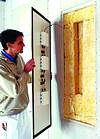
The world of speaker-free sound, where the walls themselves become the speakers has arrived. Now you can listen to Handel’s ‘Water Music’ playing from the bathroom tiles while you take a shower, feel the house shake with the footsteps of dinosaurs while you watch ‘Jurassic Park’ on your home entertainment system and hear Robbie Williams as if he is literally singing in your living room.
A new speaker-less sound system has been developed by German polyurethane specialist Puren, where the walls, ceilings and floors produce the sound themselves. Puren developed the system in cooperation with Siemens and Bayer MaterialScience, one of the largest plastics producers in the world.

Said Hans Bommer, managing director of Puren: "The principle of generating sound using a vibrating surface rather than through speakers in the usual way is based on a Siemens patent. The only thing missing up till now was a really good digitally-controlled soundboard. Now, after just 18 months of development, we are ready to unveil the complete system."
The heart of the 'pursonic' sound technology is a thin soundboard. This element is composed of a special polyurethane made from the Bayer raw materials Desmophen and Desmodur. These materials allowed the thickness of the board to be reduced to seven millimetres, which means it takes up the minimum of space in the wall and is still highly stable. The company gives the example of an acoustic guitar sound. This also makes the thin outer walls vibrate, but unlike the trumpet, it does not generate a strong air pressure wave. So how does it work exactly?
"Ah well, that is our secret," smiles Bommer. "All I can say is, it took hundreds of attempts to arrive at the sound we were looking for."
Ensuring that the speaker elements still sound good when they have been fitted into walls, ceilings and floors and covered with plaster, carpet or tiles, high-precision digital technology is required. That is where Siemens comes in. Every soundboard is made to vibrate by sound generators on the reverse side. These receive signals from a freely programmable digital processor. The company says the art lies in the fine-tuning of the frequencies - treble, mid-range and bass - to the surface material of the wall behind which the soundboard is concealed. Emission angles are also almost twice the width of those of standard speakers, eliminating the so-called 'sweet spot' as with standard speakers.
© Technews Publishing (Pty) Ltd | All Rights Reserved